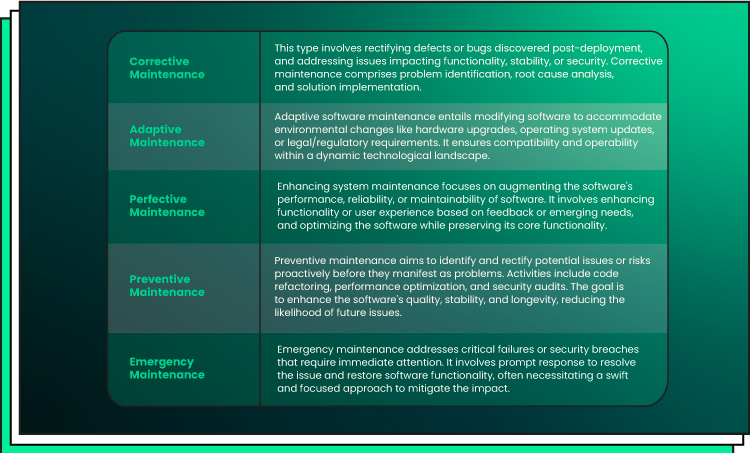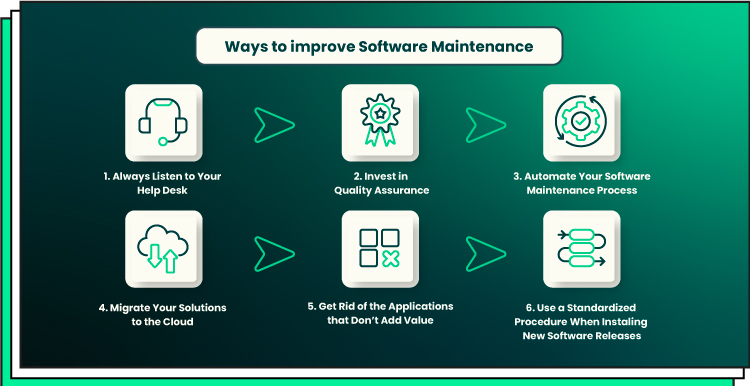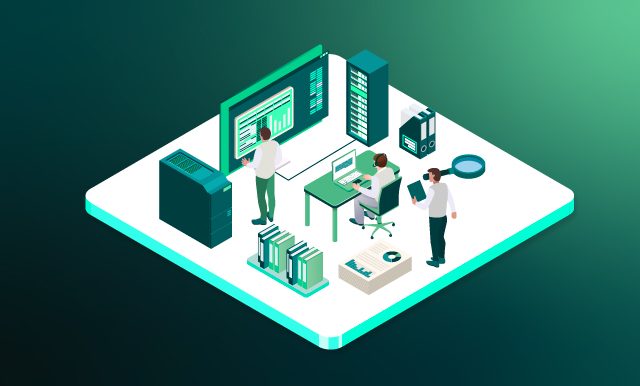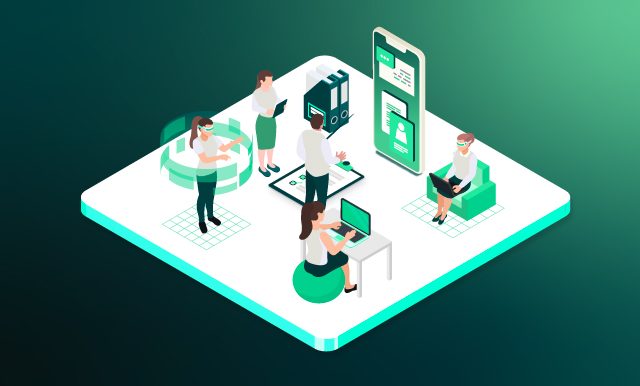Picture this: you’re running a business, and your software is like the engine that powers your operations. It’s smooth, efficient, and keeps everything humming along. But just like any engine, it needs a little TLC (tender loving care) to keep it firing on all cylinders. We invite you to enter the world of software maintenance — the unsung hero that ensures your software performs at its best and has a long, healthy lifespan.
Long story short, software or system maintenance is the process of managing and enhancing software applications throughout their lifecycle, including constant code refactoring, engineering reviews, and performing deeper upgrades when necessary.
In this article, we’ll take you on a journey through the fascinating theory and practice of software maintainability. We’ll unravel the mysteries behind bugs, security vulnerabilities, and performance issues, and show you why staying ahead of these problems is more important than ever. Plus, we’ll share some insider tips and best practices that will make your software maintenance planning process as smooth as butter.
At Forbytes, we understand the critical role software maintenance plays in keeping businesses thriving in the digital era. Our team of skilled developers, testers, and system engineers is here to take the burden off your shoulders, so you can focus on what you do best – growing your business.
But first, let’s dive into the importance of software maintenance management and the ways it can benefit your business. Buckle up, because we’re about to take your software on a joyride to optimal performance and longevity — so let’s hit the road.
Planning Stage: Exploring Different Types of Software Maintenance
The maintenance phase of the software development life cycle encompasses various types, each serving a specific purpose in ensuring the functionality and currency of software systems. Here are the key types of software maintenance:
- Corrective software maintenance
- Adaptive software maintenance
- Perfective software maintenance
- Preventative software maintenance
- Emergency software maintenance
Check the detailed explanation of each type below:


5 Reasons to Embrace Sustainable Software Maintenance Strategies
The maintenance phase is the penultimate phase of SDLC, but it lasts as long as the software product remains active. By addressing bugs, enhancing performance, ensuring compatibility, and incorporating user feedback, businesses can maximize the value and effectiveness of their software. In this section, we will delve into the key reasons why the software maintenance process is essential for businesses.
Addressing software bugs and security vulnerabilities
No software is immune to bugs or security vulnerabilities. As applications grow in complexity and scale, the likelihood of encountering issues increases. Regular software maintenance allows businesses to:
- Identify and fix these bugs promptly
- Ensure the software operates smoothly and securely
- Proactively find and address vulnerabilities
- Safeguard sensitive data and protect their reputation
- Minimize the risk of costly security breaches.
But it doesn’t stop there. A software maintenance plan brings predictability and consistency to the table. Gone are the days of relying on occasional or irregular debugging efforts. Instead, a systematic and iterative software engineering approach ensures the ongoing improvement and well-being of your software product.
Optimizing performance
Software applications need to perform optimally to meet user expectations. Over time, as new features are added and data accumulates, the performance of software may degrade. Maintenance activities such as code optimization, database tuning, and performance monitoring help identify bottlenecks and fine-tune the software application for optimal performance.
By ensuring efficient computing resource utilization and minimizing response times, businesses can provide a seamless user experience and competitive edge in any industry, including modern virtual entertainment projects and electronic banking applications.
Ensuring compatibility
The software landscape is in a constant state of evolution, with new operating systems, hardware configurations, and dependencies introduced regularly. Without the proper software maintenance process, software applications can fall out of sync with the latest technologies, resulting in compatibility issues. That’s where regular updates and compatibility testing come into play.
By staying proactive and conducting thorough compatibility assessments, businesses can adapt to evolving environments. This ensures that their software products remain stable and usable across various platforms, devices, middleware updates, and other changes in versions of related software.
Incorporating user feedback
End-user feedback is invaluable for improving software applications. Users often encounter issues or suggest improvements that can enhance functionality or user experience. Software maintenance activities provide an opportunity to gather and analyze user feedback, incorporating valuable insights into future updates and releases.
By addressing user needs and expectations, businesses can build stronger relationships with their customers and gain a competitive edge.
Revitalizing software for longevity & relevance
To ensure your software stands the test of time, embracing software maintenance becomes the key. Through regular updates and improvements, your software retains its relevance and value in an ever-evolving landscape. It adapts to emerging technologies, catering to the evolving needs of users.
By embracing the practice of software maintenance, your software remains a formidable competitor, always one step ahead in the dynamic market.
Best Practices for Effective Software Maintenance
The management of software maintenance is a distinct discipline that involves various practices and methods. A suitable combination of these practices ensures the smooth and effective maintenance of software applications.
In this section, we will delve into the key aspects of software maintenance management and explore the practices that contribute to its success. Let’s explore the pillars of efficient software maintenance management and unlock its potential for sustained software excellence:
Regular updates and patches
Regular software updates and patches are essential for maintaining software integrity and security. To establish a robust update cycle, organizations should consider the following:
- A well-defined update schedule. It includes bug fixes, security patches, and feature enhancements. This ensures that the software remains up-to-date and protected against emerging threats. According to the BlackBerry team, approximately 2,252 new instances of malware are unleashed into the digital world every day, which is equivalent to roughly 1.5 new samples appearing every minute.
- Automated update mechanisms. They streamline the process, making it seamless for users to receive and install updates. This eliminates the hassle of manual updates and ensures that users have access to the latest version effortlessly.
- Regression testing. This type of testing takes place after the execution of updates and patches. It ensures that the changes do not introduce new bugs or conflicts.
- Effective communication. Use appropriate channels to inform users about the availability of software updates, their benefits, and any necessary actions to be taken to update their systems. Clear and timely communication fosters transparency and encourages users to keep their software up-to-date.
- Feedback mechanisms. Gather user input on updates and patches. User feedback provides valuable insights into the impact of updates and helps identify any issues that may arise.
Proactive monitoring and testing
Monitoring software performance and conducting proactive testing are crucial aspects of effective maintenance. Automated monitoring tools can provide insights into operating system behavior, identifying potential issues before they impact users. Additionally, implementing a robust testing strategy, including regression testing, load testing, and security testing, helps identify and resolve issues early in the software lifecycle, reducing the overall effort involved in maintenance tasks.
Here’s how:
- Code optimization. Dive into the codebase, hunting down inefficiencies and streamlining the logic. By optimizing the code, you can eliminate bottlenecks and improve overall performance.
- Database tuning. Fine-tune your databases, ensuring they are properly indexed and structured for efficient data retrieval. This optimization can significantly speed up queries and improve response times.
- Performance monitoring. Keep a vigilant eye on your application’s performance metrics. Set up monitoring tools to track resource utilization, identify performance hotspots, and make data-driven optimizations.
- Efficient resource utilization. Make sure your software is using system resources wisely. Optimize memory usage, minimize unnecessary computations, and fine-tune configurations to achieve maximum efficiency.
- Minimizing response times. Every second counts. Identify areas where response times are sluggish and implement optimizations to reduce latency. Whether it’s optimizing network requests or improving algorithmic efficiency, shaving off those precious milliseconds can greatly enhance the user experience.
Documentation and version control
Maintaining comprehensive documentation and version control is vital for efficient software maintenance. Documenting changes, known issues, and troubleshooting procedures simplifies the debugging process and aids in knowledge transfer. Version control systems enable teams to track changes, revert to previous versions if needed, and collaborate effectively, ensuring transparency and accountability throughout the maintenance process.
Collaboration and communication
Software maintenance often involves multiple stakeholders, including developers, testers, support teams, and end-users. Establishing clear channels of communication and collaboration is essential for effective software maintenance. Regular meetings, ticketing systems, and collaboration tools facilitate seamless coordination, ensuring that everyone is on the same page and can contribute to the ongoing improvement of the software.

Benefits and Outcomes of a Meaningful Approach to Software Maintenance
Enhanced software performance
Regular software maintenance leads to improved performance, ensuring that the application operates smoothly, responds quickly, has a disaster recovery plan, and handles increasing loads efficiently. This activity helps businesses optimize code, databases, and operating system configurations. What’s more, they get the chance to enhance the overall user experience by fully meeting user requirements, reducing frustration, and maximizing productivity.
Cost savings in the long run
Investing in software maintenance can lead to significant cost savings for businesses. By addressing issues early on, organizations can avoid:
- Major breakdowns
- Critical errors
- Data loss
- Security breaches that would require expensive emergency fixes or damage control.
Furthermore, maintaining software applications throughout their lifecycle is often more cost-effective than starting from scratch. This is especially true when considering the reusability and scalability of existing software assets. By prioritizing software maintenance, businesses can optimize their financial resources and achieve long-term cost efficiency.
Improved user satisfaction
Software maintenance that incorporates user feedback and continuously enhances the application leads to increased user satisfaction. By providing regular updates, addressing bugs promptly, and adding valuable features, businesses demonstrate their commitment to meeting user needs. Satisfied users are likelier to be loyal customers and advocates for the software, driving positive word-of-mouth and attracting new users.
Extended software lifespan
Well-maintained software applications have a longer lifespan compared to those neglected after deployment. By actively managing and improving software, businesses can extend their useful life, ensuring a higher return on investment. Additionally, a longer software lifespan allows organizations to plan for future software upgrades and migrations effectively, minimizing disruption to their operations.
Competitive advantage
Software maintenance plays a vital role in maintaining a competitive edge. By continuously improving and adapting software applications, businesses can:
- Differentiate themselves from competitors by offering enhanced functionality and unique features that set them apart.
- Provide a reliable, secure, and feature-rich software solution that meets the evolving needs of customers.
- Establish an efficient DevOps environment to streamline the process of rolling out software changes, ensuring quick and seamless updates.
- Position themselves as industry leaders by demonstrating their commitment to continuous improvement, attracting both customers and partners alike who seek innovative and reliable software solutions.
By prioritizing software maintenance, businesses can gain a significant competitive advantage, staying ahead of the curve and positioning themselves as leaders in their respective industries.
Real-Life Case Studies of Software Maintenance Services
Guesty
Forbytes’ team leaders bolster Guesty’s teams with their expertise in project leadership, technology selection, and the development of software products. They collaborate with software product engineers and product designers to explore avenues for optimizing and enhancing outdated or challenging-to-maintain solutions.
As integral members of the R&D teams, Forbytes’ professionals also contribute to the addition of new features and third-party integrations. Leveraging these integrations, Guesty streamlines its back-office operations, ultimately enhancing business outcomes for end-users.
Starweb
Collaboratively, we are focused on enhancing the platform’s architecture and constructing a new API. Starweb currently relies on a monolithic architecture, which affects performance and hinders data transfer speed. The API under development will serve as the foundation for a new architecture, facilitating software maintenance and scalability of the platform.
Our skilled software engineers are devising plans to optimize the Starweb platform, revamp the codebase, and introduce new functionality by leveraging the power of the API.

Why Go for Outsourcing Software Maintenance
Outsourcing software maintenance planning and execution to specialized service providers like Forbytes enables businesses to adapt to emerging technologies and industry standards. With their expertise, industry best practices, and dedicated resources, organizations can ensure their software remains relevant, scalable, and compatible with future environments.
By partnering with trusted IT professionals, businesses can focus on core activities while leveraging external knowledge to ensure the ongoing success of their software. Outsourcing software maintenance offers flexibility and expertise, positioning organizations for long-term growth and innovation in the ever-changing digital landscape.
Conclusion
Software maintenance is a critical component of managing and enhancing software applications. It’s necessary to include the software maintenance phase in SDLC for any software product that is going to stay competitive in the market. By addressing bugs, security vulnerabilities, and performance issues, businesses can ensure optimal performance, longevity, and user satisfaction.
Through regular updates, proactive monitoring, and collaboration, organizations can future-proof their software, adapt to evolving technologies, and gain a competitive advantage. By recognizing the importance of software maintenance activities and implementing best practices, businesses can maximize the value of their software investments and drive sustainable success.
If you need profound consulting in terms of your software product maintenance, make sure to contact Forbytes for more information and schedule a complimentary call with our skilled software engineers.

Our Engineers
Can Help
Are you ready to discover all benefits of running a business in the digital era?

Our Engineers
Can Help
Are you ready to discover all benefits of running a business in the digital era?









